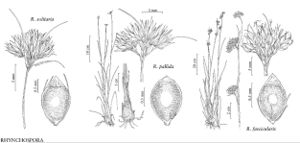Rhynchospora fascicularis
Enum. Pl. 2: 234. 1805.
Plants perennial, cespitose, 100–150 cm; rhizomes absent. Culms erect to excurvedascending, narrowly linear to ± filiform, terete to obscurely trigonous, leafy, densely so toward base, stiff to rather lax. Leaves overtopped by culm; blades linear, ascending, proximally flat, 1–4 mm wide, apex trigonous, subulate, tapering gradually. Inflorescences: spikelet clusters 1–3 (–4), proximal mostly widely spaced, dense, broadly turbinate to hemispheric, to 2 cm broad; leafy bracts subulate, exceeding proximal spikelets, slightly or not exceeding most distal clusters. Spikelets redbrown, narrowly ovoid, (3–) 3.5–5 mm, apex acute; fertile scales ovate, 3–3.5 (–4) mm, apex acute, mostly with cusp or mucro 0.5–1 mm. Flowers: bristles 5–6, from rudimentary to reaching tubercle tip, or (rarely) beyond, antrorsely barbellate. Fruits 1–3 per spikelet, (1.5–) 2–2.2 (–2.5) mm; body dark-brown with pale center, lenticular, broadly ellipsoid to ± orbicular, (1.3–) 1.5–1.7 (–1.9) × 1–1.5 mm, margins pale, narrow or narrowly rounded, flowing to tubercle; surfaces dull, minutely longitudinally striate; tubercle compressed, triangular to triangularsubulate, 0.5–0.7 (–0.9) mm.
Phenology: Fruiting late spring–fall or all year (south).
Habitat: Sands and peats of interdunal swales, depressions in savannas, open flatwoods, and seep-bog edges
Elevation: 0–100 m
Distribution

Ala., Fla., Ga., La., Miss., N.C., S.C., Tex., Va., Bermuda, Central America
Discussion
In her revision, S. Gale (1944) treated var. distans as the more slender version of the species, one with a smaller inflorescence, more distinctly margined fruit body, and consistently elongate perianth bristles. All those character states appear to vary independently over the total range of the species.
Selected References
None.
Lower Taxa
"shortened" is not a number."wider" is not a number.
